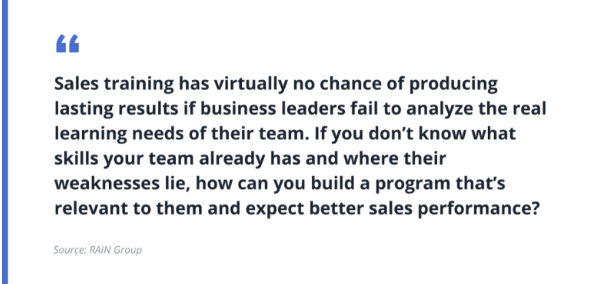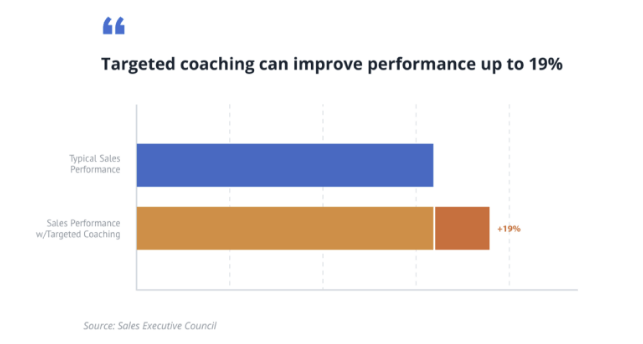Here’s the most game-changing message you’ll read today: Sales training and coaching generally fall flat if you don’t have visibility into frontline sales conversations.
Let’s talk about why.
Most sales teams receive training, your team probably does too. Perhaps you’re a fan of The Challenger Sale and SPIN Selling. Or maybe you’ve sprung for tailor-made, internally delivered training, or a generic/tailored hybrid.
No matter the approach, do you ever wonder why, when everyone on your team receives the same training, a performance gap still exists between your star reps and your average performers?
ALSO READ: 4 Sales Gamification Ideas to Improve Performance
The star reps outsell everyone else by about the same amount, despite the fact that both groups have received the same baseline training.
The fact is, sales training only works when it’s based on the specific needs of your team. But don’t take my word for it. The RAIN Group agrees.

Does that seem easier said than done?
The fact is, identifying your team’s true needs is difficult when you don’t know what they’re struggling within their sales conversations. And, sadly, even if you’ve polled them to find out what they think they need, that data may not reflect reality. The training needs they express in a survey and what they actually need are usually two different stories.
In the end, sales training that’s designed without a deep understanding of what’s happening during your team’s sales conversations ends up being generic or, even worse, not rooted in your team’s reality.
Maybe it wouldn’t matter so much if sales training was cheap. But companies spend a lot of money on these programs. The tab can range from $3,500 to $25,000 per day for tailored programs, and from $500 to $5,000 per participant for publically available, one-size-fits-all programs.

The bottom line is that, regardless of whether your training budget is shoestring or deluxe, without visibility into frontline sales conversations, you can’t know if it is actually being implemented on the ground‚Äîevery day, in every conversation.
Actually, I take that back. I can tell you it’s very likely that it isn’t.
How do I know?
Because 30 days after training, almost 87 percent of participants revert back to their old behaviors, and the benefits are lost.

You need visibility if you’re going to target, monitor, measure, and reinforce the desired behaviors, in real time and over time.
Sales coaching falls short without visibility
The same is true of sales training and coaching. Without visibility into sales conversations, identifying each rep’s coaching needs is just guesswork. This is frustrating and demoralizing for the sales rep who doesn’t improve, even with coaching. And it’s frustrating for the coaches who don’t get the results they want. It’s also dangerous to coach without visibility into sales conversations.
Why?
Coaching is a diagnostic discipline, and poor coaching, addressing the wrong things in the wrong ways, can make matters worse.
Over 60% of salespeople are more likely to leave their job if their manager is a poor coach.
It’s a painful truth: In many cases, you’d be better off with no coaching rather than coaching that isn’t based on facts, reality, data and conversation intelligence. It’s like a doctor writing a prescription without knowing the underlying problem.
And even if you guess the right issues to target, without visibility into conversations, you can’t know if your coaching is being acted on.
Coaching without visibility into a reps’ sales conversations is like going to surgery without an x-ray.
Remember, coaching is meant to address the fact that 87 percent of sales training is forgotten within 30 days. You want to reinforce the training, and that means you need visibility into the conversations your team is having. You can’t ignore what’s being said on the ground.
ALSO READ: How to Coach Your Sales Reps Using Call Recordings
There is good news
As you might have guessed, the flip side is that when you have visibility, training and coaching become extremely effective.
Your training becomes surgically precise and rooted in reality. You can coach to specific, unique needs, and check to see that your reps consistently implement what they learn.
Suddenly, your ROI on all those training dollars skyrockets.

Visibility into sales conversations turns you into a powerhouse coach. With a concrete understanding of each rep’s unique coaching needs, you can drive lasting behavioral change.
This is the crux of closing the quota attainment gap between your stars and the rest of the team:
With visibility into their conversations, you can provide targeted coaching and be sure that your sales process is executed with focus and discipline. You can use data from actual, real-time conversations to constantly refine it.

Once you have this data, the disconnects in your sales process will become plain as day and you can target your training and coaching accordingly. That’s how you’ll turn your sales process into a reliable, revenue-generating machine. That’s how you’ll close the performance gap that separates your top reps from everyone else on the team.
Chris Orlob is senior director of product marketing at Gong.io. Gong.io helps you close the performance gap between your top reps and everyone else by recording, transcribing, and analyzing their sales conversations.


